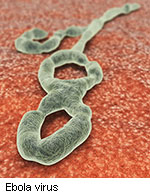
THURSDAY, Oct. 2, 2014 (HealthDay News) — Health officials in Texas are closely monitoring a potential second Ebola patient who had close contact with Thomas Eric Duncan, the first person to be diagnosed with Ebola in the United States, according to news reports.
In related news, officials at the U.S. Department of Health and Human Services said they are hoping to fast-track production of Zmapp, an experimental drug that may help treat the deadly virus but is currently in short supply.
In an interview Wednesday with WFAA-TV in Dallas-Fort Worth, Zachary Thompson, director of Dallas County Health and Human Services, said the second potential patient is one of several people who had contact with Duncan, a Liberian national who arrived in the United States on Sept. 20 to visit family in the Dallas-Fort Worth area.
“Let me be real frank to the Dallas County residents: The fact that we have one confirmed case, there may be another case that is a close associate with this particular patient,” Thompson said. “So this is real. There should be a concern, but it’s contained to the specific family members and close friends at this moment.”
Thompson said the public isn’t at risk because health officials have the virus contained, WFAA-TV reported.
Overall, federal health officials are monitoring up to 18 people who may have been in contact with Duncan.
Some of the 18 people are members of the man’s family. The group of 18 also includes five schoolchildren as well as the three-member ambulance crew that transported Duncan on Sunday to Texas Health Presbyterian Hospital, according to published reports.
Duncan may have had contact with the five children at a home in Texas over the weekend. The children attend four different schools, including a high school, a middle school and two elementary schools. The schools will remain open but will undergo a thorough cleaning as a precaution, The New York Times reported.
The ambulance workers have tested negative for the virus that has been ravaging several West African nations, and are confined to their homes for observation, the Associated Press reported.
“If anyone develops fever, we’ll immediately isolate them to stop the chain of transmission,” Dr. Tom Frieden, director of the U.S. Centers for Disease Control and Prevention, told the AP.
People who had contact with Duncan will be monitored for fever during the next 21 days, which is the maximum incubation period for Ebola, Frieden said.
Duncan flew to the United States from Liberia after quitting his job with a shipping company in Monrovia, Liberia, one of the West African nations battling the Ebola outbreak, the Times reported. He first developed Ebola symptoms Sept. 24 and sought care two days later, but was released from the hospital. Some hospital officials weren’t aware at the time that he had been in West Africa, the AP reported.
He was taken to Texas Health Presbyterian Hospital after his condition worsened.
Duncan is the first patient ever diagnosed with Ebola in the United States, and the first patient outside of Africa to ever be diagnosed with the Ebola Zaire strain, Frieden said at a Tuesday news briefing.
“The bottom line here is that I have no doubt we will control this case of Ebola so it will not spread widely in this country,” Frieden said at the briefing.
The Times also reported late Wednesday that officials at the U.S. Department of Health and Human Services are discussing increasing production of Zmapp with Caliber Biotherapeutics, a Texas-based company that uses tobacco plants to produce the medicine in large quantities.
Separate efforts in collaboration with two of the world’s biggest charities — the Bill and Melinda Gates Foundation and the Wellcome Trust — would have HHS coordinate production of Zmapp using animal cells. According to the Times, that method would take longer, but, once up and running, would tap into the resources of the world’s pharmaceutical companies, vastly increasing output.
Still, even with these efforts, experts estimate that only hundreds or thousands of treatment doses would be available by early 2015.
Zmapp was used over the past few weeks to help treat seven patients, including American aid workers Dr. Kent Brantly and Nancy Whitebol, who became infected in West Africa. They and three others survived, but two patients who got the drug died.
Frieden stressed that Ebola is not easily transmitted — to become infected a person must come into direct contact with the bodily fluids of a person who is suffering symptoms. Those symptoms include fever, muscle pain, vomiting and bleeding and can appear as long as 21 days after exposure to the virus.
The Duncan case in Dallas is the sixth to be treated in the United States since the Ebola outbreak began in West Africa last spring. An unidentified American doctor who had been working in Sierra Leone is currently being cared for at a hospital at the U.S. National Institutes of Health in suburban Washington, D.C.
Three others — including Brantly and Whitebol — who became infected with the virus have recovered, while a fourth continues to undergo treatment at Emory University Hospital in Atlanta.
The Ebola epidemic in West Africa is the worst outbreak ever of the disease. So far, an estimated 6,500 people have become infected and nearly 3,100 have died in the countries of Guinea, Liberia, Nigeria and Sierra Leone, according to the World Health Organization.
The epidemic could strike as many as 1.4 million people by mid-January unless the global community mounts a rapid response to the crisis, according to estimates by the U.S. Centers for Disease Control and Prevention.
More information
For more information on Ebola virus, visit the U.S. Centers for Disease Control and Prevention.
Copyright © 2024 HealthDay. All rights reserved.

